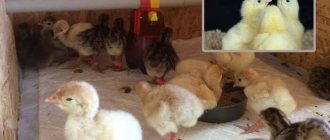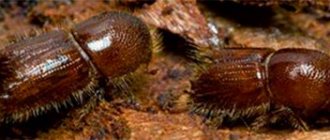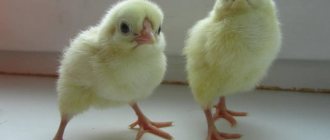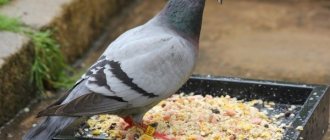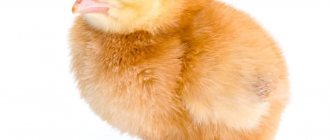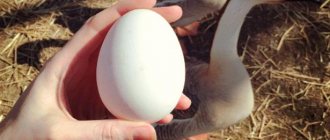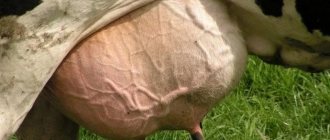1 783
3 comments
0
Author of the article
Sadchikov Nikolay Alekseevich
Reading time: 4 minutes
Temperature is one of the main criteria for assessing the state of the body of a warm-blooded animal, which includes birds. A decrease or increase in thermometer readings by several degrees leads to metabolic disorders, and in some cases, to death.
What does temperature depend on?
In every living organism, the temperature directly depends on internal physiological processes, the speed and optimality of metabolism. The intensity of metabolism is directly proportional to the release of thermal energy during the breakdown of substances.
Environmental conditions also affect body temperature, since the body constantly exchanges energy with it. Excessive cold and unbearable heat can negatively affect the life of chickens and lead to various negative consequences.
What temperature can chickens withstand in winter?
No time to read? We will send the material to you by: Mail. By clicking on the button, you consent to the processing of your personal data.
On large poultry farms, chickens lay eggs all year round, but in households, productivity decreases greatly with the onset of cold weather. Obviously, the temperature in the chicken coop affects the egg production of birds. In order for birds to continue to provide poultry farmers with eggs in winter, it is necessary to create good conditions for them. Chickens lay eggs to produce offspring. Their peak productivity occurs in the spring and summer.
The content of the article.
How to measure a chicken's temperature?
You can measure the temperature of poultry using a regular medical thermometer. Initially, lubricate the tip of the thermometer with moisturizing cream or Vaseline, so as not to injure the chicken or harm it in the process, and then carefully insert the device into the cloacal opening of the hen, while holding it tightly.
To ensure data accuracy, repeat the procedure throughout the day, and then calculate the average statistical indicator.
Important! It is more convenient to use an electric thermometer because it shows results faster and is safer to use.
What temperature should the chicken coop be?
Only by maintaining the temperature regime can the good condition of the bird and its productivity be maintained. The permissible temperature for breeding laying hens is +5. +28 °C, optimal - +10. +25 °C. To regulate it, a thermometer is installed in the chicken coop.
In winter, the thermal regime is acceptable within +10. +18 °C. In summer, the heat level in the poultry house should not exceed +27. +30 °C.
Normal temperature for chickens
The normal temperature for chicken should be 40-42 degrees. Any deviations may indicate serious problems.
When hatching, the temperature of the chicken is of great importance, since the eggs will develop well only if there is a programmed norm. Many experts indicate in literary sources that the quonka’s body temperature should increase, but their opinion is wrong. In the first week it varies from 38 to 39 degrees, and in subsequent days it gradually rises to 40.
Chicks have slightly lower temperature parameters than adults. After hatching, they are not able to maintain this indicator on their own, so they need heating.
Deviations from the norm
Recognizing the problem
Knowing what the chicken’s body temperature is, we can draw conclusions about its health. A thermometer reading above 42.1°C indicates problems.
The cause may be dangerous infectious diseases or violation of the conditions of keeping the poultry. In the first case, it is recommended to take urgent measures, which will be discussed below.
In the second option, the situation can be corrected by organizing comfortable conditions for the chicken.
Symptoms signaling illness
Fever is just one sign of infection. It is often accompanied by other symptoms:
- secretion of mucus from the nostrils and eyes of the chicken;
- lack of appetite;
- abnormal stool: foamy discharge, green diarrhea;
- lethargy, drowsiness.
If a bird exhibits these symptoms, it should be immediately isolated from the rest of the flock and a veterinarian should be called. It may have to be disposed of to prevent the death of the entire livestock.
Ambulance in the absence of a veterinarian
If it is not possible to show a sick individual to a specialist, you can try to cure it yourself.
The chicken must be moved to a room where it is warm, dry and calm. Drink a weak, pale pink solution of potassium permanganate (manganese). Replace your usual food with high-quality dry food.
What does a bird's fever mean?
Elevated temperature appears when chickens develop pasteurellosis, coccidiosis, smallpox, typhus, salmonellosis, mycoplasmosis, and bird flu.
In case of illness
Chickens are susceptible to many diseases. The most common diseases: bird flu, bronchitis, paralysis, atypical plague. The first noticeable signs of almost all infections include the following symptoms:
- lethargy when moving;
- lack of appetite;
- the appearance of mucus on the eyes and beak;
- diarrhea.
See also
The best lamp options for heating chickens, features of infrared and ceramicRead
Diseases can be diagnosed in a more modern way by using a medical thermometer. If you monitor and analyze the external signs of the disease, you can accurately determine the disease.
Roman blinds have long been a favorite and a cozy corner in the heart of every self-respecting designer. Nowadays, decorating the interior with a Roman blind is a tribute to fashion, which today cordially allows your imagination to go as far as you want. Roman blinds can be made from fabrics of any texture and color, using additional accessories.
The technology for making a Roman blind came from Roman sailors - this curtain folds according to the same principle as the immense sails on ancient ships.
The idea of a curtain as a small piece of fabric, which can be lowered and raised using a system of strings and their guides, appealed to the seaside population of Ancient Rome. Such curtains made it possible to use fabric economically and create protection on the window from mosquitoes, cool night breezes and slanting streams of rain. I chose fabric for the curtains with a dense weave of thick threads, and quite often I sewed them from the same ship’s canvas.
So, custom-made Roman blinds are a flat strip of fabric (the width of the window opening), which is divided into equal horizontal sections. A ribbon is sewn along the edge of each section, inside which a metal strip is inserted (it is needed to ensure that the folds of the curtain keep their even shape).
And to each horizontal line separating the sections, a system of rings is attached, along which a twine slides, pulling and straightening the folds of the curtains.
Metal strips are not always sewn into curtains. Sometimes, if the curtain fabric is transparent, we don’t want the slats and rings to show through the curtain, and then we do without the slats, and choose very small rings (made of transparent plastic), and place them only on the side edges of the Roman blind.
There are no restrictions on the choice of colors for Roman blinds. They can be sewn from plain fabric or made from patterned tulle. The striped versions of the Roman blind are especially nice.
A Roman blind, if desired, can completely block out sunlight if you choose fabrics marked Black (this is a fabric with a special treatment on the reverse side).
Light Roman blinds with a delicate pattern.
A Roman blind made of light fabrics with a discreet chalk print looks beautiful. What’s even more important is that it’s very easy to care for a light-colored and therefore branded Roman blind - it is attached to the window opening with regular Velcro, so it’s easy to remove and reattach after washing.
The smooth surface of the curtains allows a beautiful pattern or design to remain visible, unlike a classic curtain, on which the pattern is always hidden from view in deep folds.
Other causes of increased or decreased temperature
In addition to the disease variant, there may be numerous other reasons for changes in the indicator, which also should not be ignored.
Exhaustion and stressful situations
Poultry is accustomed to strictly following a schedule and does not welcome any deviations from the daily routine. A low temperature is typical for an exhausted chicken that does not feel full after eating or does not receive food in a timely manner. Symptoms of exhaustion are:
- lack of activity;
- loss of feathers;
- a small number of eggs.
Also, thermoregulation is disrupted due to stress, which often occurs as a result of an attack by a predator, in the process of moving a bird to another group or to a new area, or changes in diet and schedule.
Cold
Hypothermia often occurs in chicks.
From the first days of life, you need to create comfortable conditions by placing them in a dry place with a temperature of 29-30 degrees.
In winter, keep poultry warm, where it is more than 5 degrees. High humidity levels increase the risk of hypothermia. The main symptoms of hypothermia include the following:
- trembling, lethargy;
- lack of appetite;
- discharge of mucus from the nostrils;
- shortness of breath;
- ridge frostbite.
This reason can be easily eliminated with proper care and creating optimal conditions for life in the chicken coop.
Heat
If the temperature in the chicken coop is more than 30 degrees, the bird becomes hot and uncomfortable. The following signs indicate overheating:
- slightly open beak;
- weakness;
- lethargy;
- lack of appetite;
- rapid breathing;
- half-opened wings.
Due to physiological characteristics and the absence of sweat glands, the metabolic process in poultry does not cause cooling of the body.
See also
10 best methods for determining the sex of a chicken yourselfRead
Important! Elevated ambient temperatures can cause heat stroke and lead to the death of the bird.
"Thermal stability".
The bird adapts relatively easily to changes in external temperature, but sharp fluctuations affect its condition and productivity. Optimal external temperature for:
- adult chickens and turkeys 12-16 °C,
- ducks and geese 7-14 °C.
The maximum temperatures that non-acclimatized chickens were able to withstand in laboratory conditions for 7 hours ranged from 38.0-40.0 °C. In field conditions, when the air temperature rises to 37.8 °C, there is a danger of chickens dying from heat stroke. Air humidity has a certain influence on the ability of chickens to withstand high temperatures. For chickens, the maximum air humidity is considered to be 80%; at a humidity below 75%, the best conditions for productivity are created, and at a humidity below 55%, chickens can more easily tolerate ambient temperatures above 29 °C. Chicks are more resilient in high temperatures than adult chickens. The maximum that day-old chicks were exposed to higher temperatures was about 41°C. Temperatures above 32°C reduce the growth rate of chicks. Breed differences in resistance to high temperatures and acclimatization. Comparative cross-breed studies have shown that at an air temperature of 29.5 °C there are no differences in the reaction of chickens of individual breeds. But at higher temperatures, light rocks are better adapted to them than heavy rocks. In conditions of an air temperature of 40.5 °C and a relative humidity of 25%, white Leghorns feel better than other breeds, while Rhode Islanders and Australorps feel much worse. Minorcas and white Wyandots occupy an intermediate place in this regard. Brown Leghorns do not tolerate hot and dry conditions, but at the same temperature and humidity, 75% are in better condition than other breeds. Local chickens in tropical climates can tolerate air temperatures above 43 °C. Obviously, these bird species are able to dissipate all excess heat, which is possible either with a lower metabolic rate or with a greater efficiency of the respiratory mechanism.
Helping chickens in high and low temperatures
Before taking appropriate measures, you need to identify the exact cause of changes in the chicken's metabolism. If the cause of your illness is stress, it is worth eliminating all its sources.
When the reading on the thermometer exceeds the norm due to overheating in chickens, you should:
- Install a blower or a special cooling system in the chicken coop.
- Equip the poultry house with additional drinkers, since liquid consumption in chickens increases up to 8 times a day. Combine water with micronutrient solution.
- Feed during periods of the day when poultry are less exposed to direct sunlight, early in the morning or late in the evening. Under such conditions, increase the energy value of the feed.
In the case of hypothermia, the solution to the problem depends on the severity of hypothermia. All measures should be aimed at intensively warming the bird:
- plenty of warm drinks;
- lubricating the integument with fat;
- place in a warm, dry place.
If all of the above measures do not lead to a positive result, and the indicator remains the same or continues to rapidly decrease or increase, then you must immediately contact a veterinarian.
The impact of climatic conditions on chicken productivity.
In tropical climates, the dependence of poultry productivity on environmental factors is much more pronounced than in the temperate zone:
- air temperature and humidity;
- light conditions;
- feeding.
These factors can be combined into broader concepts such as
- geographic latitude;
- climate zone;
- season of the year.
Daylight hours.
One of the main natural conditions affecting the egg production of chickens is seasonal changes in daylight hours and lighting intensity.
The bird's eye is very sensitive to light intensity. Through the retina of the eye, light causes the entry of gonadotropic hormone into the blood, which stimulates the activity of the ovaries.
Temperature and humidity.
Along with the factor of daylight hours, the change in the productivity of chickens throughout the year is greatly influenced by the temperature and humidity of the environment. These factors are closely interrelated in nature, as a result of which it is difficult to draw a clear line between their influence on the seasonal productivity of chickens. It is considered established that in the temperate zone, the length of daylight hours is the main factor influencing the seasonal rhythm of productivity of laying hens. In subtropical and tropical areas, this dependence becomes more complicated due to the depressive effect of high air temperatures on egg production. Thus, in a number of studies it was found that when laying hens were kept at a temperature of 29 °C or 32 °C, 72 and 74% of eggs were obtained from them, respectively, compared with a temperature regime of 13 °C. The productivity of chickens can change especially dramatically in the subtropics, where, with dry and hot summers, seasonal changes in temperatures can be quite large. In this region, the lowest egg production of chickens coincides with the highest external temperature, which usually occurs in August-September. As the external temperature decreases, the egg production of chickens increases. Studying the patterns of changes in egg production of chickens by month of the year in the conditions of each climatic zone in relation to the characteristics of individual breeds and farm organization systems is of great importance. Knowledge of these patterns is necessary for planning production on the farm, timing of recruitment of a flock of laying hens, provision of livestock with feed, etc. High temperatures of the external environment in which the poultry is located cause a decrease in the mass of eggs laid. It was found that under the influence of high temperatures, the mass of eggs decreases to a greater extent due to the mass of the white than the yolk. High temperatures have a very significant effect on calcium metabolism in the bird’s body. It is known that when the air temperature rises from 21 to 32 °C, the level of calcium in the blood decreases by 25-30%. Disturbances in calcium metabolism lead to a significant decrease in the thickness of the shells of laid eggs. A particularly sharp decrease in shell thickness is observed when the temperature rises to 32 °C, and high air humidity intensified the negative impact of high temperatures.
The effect of heat and humidity on the quality of eggs is of great economic importance, since reducing the shell thickness to less than 0.35 mm makes it very fragile, which greatly complicates the storage and transportation of eggs. Evidence suggests that chicken productivity is directly dependent on meteorological conditions in tropical and subtropical countries. In certain climatic zones, this dependence can be significant, therefore, the conditions and reasons affecting poultry productivity must be studied and taken into account when organizing production processes on poultry farms.
Secrets of Low Temperature Chicken
1. Uniform baking
There is no need to tie the chicken legs together, as we are used to doing, so that the bird retains its shape when baking. The heat should envelop the entire carcass, then the cooking will be uniform.
2. Increase the moisture content of the meat
In order for the chicken to retain more moisture in the oven, it needs to be soaked in a saline solution (overnight, in the refrigerator). Salt is taken strictly 60 grams - per 1 liter. If you put more, it will dry out the meat. The chicken will “take” into itself exactly as much solution as is needed for uniform brining.
3. Temperature
In an oven that is too hot, the meat literally shrinks and squeezes all the juices out of the fibers. By roasting slowly at a lower temperature, you will keep the bird juicy. Therefore, chicken should be cooked at 90 degrees until the temperature inside the carcass (in the thickest part of the breast) reaches 75 degrees. To determine doneness, you will need a meat thermometer or temperature probe.
Total preparation time: 15 hours Cooking time: 3 hours Yield: 8 servings
Proper nutrition for chickens in winter
The nutrition of chickens has a huge impact on the level of egg production. You should try to ensure that the daily menu of the laying hen consists of the following ingredients:
- grains (wheat, barley, oats, corn);
- root vegetables, tubers, vegetables (potatoes, carrots, beets, cabbage, pumpkins);
- green herbaceous plants (nettle, dandelion, alfalfa, clover);
- micro- and macroelements (calcium, phosphorus, sodium, chlorine);
- vitamin supplements containing vitamins A, group B, D, K, E.
Feed for laying hens must be prepared in the summer - dry the herbs, place tubers and root crops in long-term storage, thresh and grind the grain.
In winter, when it is not possible to provide all the required vitamins and minerals with regular food alone, you need to add feed and premixes, for example, such as:
- "Rex Vital";
- "Ryabushka";
- "Rock Chicken";
- "Healthy."
The dosage of premixes will need to be calculated taking into account age, breed, method of keeping, basic diet, and seasonality.
Find out what to feed laying hens to help them lay eggs better.
Experts advise creating a winter menu for laying chickens, adhering to the following content recommendations:
- cereals - 120 g;
- moistened mash - 30 g;
- boiled potatoes - 100 g;
- cake - 7 g;
- chalk - 3 g;
- salt - 0.5 g;
- bone meal - 2 g;
- yeast - 1 g.
Feeding is carried out 3 times a day. A bird's breakfast should consist of grain and boiled potatoes, bran, shells, and salt. Lunch - mash, vegetables, herbs. Dinner is made from grain.
In order for the chicken to eat normally, the menu must be changed periodically, otherwise it will get boring and the bird will lose its appetite. Fresh, clean water must be present in drinking bowls. In winter, its temperature should not fall below +15 °C, otherwise the birds may get sick.
Disturbances in the gastrointestinal tract of a chicken and a drop in egg production can occur if you feed the bird:
- salt and salty foods in large quantities;
- unripe vegetables;
- potatoes turned green from long exposure to the sun;
- onions;
- legumes in dry or undercooked form;
- dry rice;
- apple seeds;
- raw eggs.
Important! When potatoes are exposed to sunlight for a long time, they produce a substance called solanine, which is toxic to farm animals and birds. Such tubers are prohibited for feeding, as they can lead to serious poisoning, even death.
Preparation
Large photosSmall photos
- We wash the chicken thoroughly, untie its legs, and cut out the gland in the tail area. Prepare a brine solution for pickling at the rate of 60 g of salt for every 1 liter of water. In total you will need 2-3 liters depending on the size of the carcass. The most important rule is that the bird must be completely immersed in the solution. If it floats, you can press it down with a weight. Leave it to marinate in this form in the refrigerator for 10-12 hours (all night).
- Remove the salted chicken from the solution. Rinse thoroughly under running water to remove excess salt. Wipe with paper towels - the skin must be dry, otherwise there will be no crispy crust.
- Place a whole lemon, scalded with boiling water, inside (you can add a few sprigs of thyme). Rub the top of the chicken with butter and ground black pepper. We seal the holes with a toothpick. Meanwhile, preheat the oven to 90 degrees.
- Place the chicken on the grill and place a deep baking tray underneath (to allow the fat to drain into it). And put it in the oven, preheated to 90 degrees. Roasting time will vary depending on the weight of the carcass. The temperature inside the meat should reach 75 degrees. Measure at the thickest part of the chicken breast.
- You don’t even have to look into the oven for the first 1.5 hours, it’s been tested several times. During this time, an average-sized carcass will have time to heat up to about 60 degrees. But after an hour and a half, you need to check the temperature every 30 minutes. I cooked a large chicken weighing 2 kg in 3 hours. As you can see, the temperature reached 75 degrees. The finished chicken will not be golden brown, its skin will be slightly tightened, but will be pale. Remove the chicken from the oven and leave at room temperature for 35-40 minutes.
- To get an appetizing crispy crust, simultaneously preheat the oven to maximum (220-250 degrees, if you have a grill, then turn it on). While the chicken is lying, it will cool slightly, the temperature inside will drop to 50-60 degrees, therefore, when achieving a golden brown crust under the grill, we will not raise the temperature of the meat higher than set, thereby maintaining the desired juiciness. So, pour the “rested” chicken with fat from the pan and return it to the oven for 10 minutes so that the skin browns. (If you have a heating pad, you can use it to heat the chicken.)
READ ALSO: Cherry plum Mara
All that remains is to cut into portions and serve. Is there any point in cooking chicken for so long? The recipe is definitely worth your attention - the meat turns out dense and juicy, completely different from what you get from traditional baking. Its structure is somewhat similar to grilled chicken. Tasty! And in principle, labor costs are minimal, it’s just that the whole process is extended over time. Try it, it’s quite possible that you won’t want to cook chicken any other way again!

